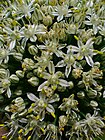Note: This is a project under development. The articles on this wiki are just being initiated and broadly incomplete. You can Help creating new pages.
Difference between revisions of "Allium cepa"
(→List of Ayurvedic medicine in which the herb is used) |
(→Identification) |
||
| (One intermediate revision by the same user not shown) | |||
| Line 2: | Line 2: | ||
'''Allium cepa''' is a herbaceous, perennial plant (usually grown as an annual or biennial in cultivation) producing 4 - 10 leaves about 30cm long and a flowering scape that can be up to 100cm tall from an underground bulb. The plant divides, forming in time a cluster of plants. | '''Allium cepa''' is a herbaceous, perennial plant (usually grown as an annual or biennial in cultivation) producing 4 - 10 leaves about 30cm long and a flowering scape that can be up to 100cm tall from an underground bulb. The plant divides, forming in time a cluster of plants. | ||
==Uses== | ==Uses== | ||
| − | {{Uses|Sores}}, {{Uses|Wasp stings}}, {{Uses|Bites}}, {{Uses|Earache}}<ref name=" | + | {{Uses|Sores}}, {{Uses|Wasp stings}}, {{Uses|Bites}}, {{Uses|Earache}}<ref name="Karnataka Medicinal Plants"/> |
==Parts Used== | ==Parts Used== | ||
| − | {{Parts Used|Bulb}}, {{Parts Used|Flowers}}, {{Parts Used|Leaves}}. | + | {{Parts Used|Bulb}}, {{Parts Used|Flowers}}, {{Parts Used|Leaves}}<ref name="Karnataka Medicinal Plants"/>. |
==Chemical Composition== | ==Chemical Composition== | ||
| Line 11: | Line 11: | ||
==Common names== | ==Common names== | ||
| − | {{Common names|sa=Palaandu|en=Onion|hi=Pyaj|kn=Irulli|ml=Bavanga|ta=Vengayam|te=Nirulli}} | + | {{Common names|sa=Palaandu|en=Onion|hi=Pyaj|kn=Irulli|ml=Bavanga|ta=Vengayam|te=Nirulli}}<ref name="Karnataka Medicinal Plants"/> |
==Properties== | ==Properties== | ||
| Line 33: | Line 33: | ||
==Identification== | ==Identification== | ||
===Leaf=== | ===Leaf=== | ||
| − | {{Leaf|||}} | + | {{Leaf|||}} |
===Flower=== | ===Flower=== | ||
| Line 71: | Line 71: | ||
<references> | <references> | ||
<ref name="chemical composition">[https://www.sigmaaldrich.com/life-science/nutrition-research/learning-center/plant-profiler/allium-cepa.html Chemical constituents]</ref> | <ref name="chemical composition">[https://www.sigmaaldrich.com/life-science/nutrition-research/learning-center/plant-profiler/allium-cepa.html Chemical constituents]</ref> | ||
| − | |||
<ref name="How to plant/cultivate">Useful Temperate plants</ref> | <ref name="How to plant/cultivate">Useful Temperate plants</ref> | ||
| + | <ref name="Karnataka Medicinal Plants">”Karnataka Medicinal Plants Volume - 2” by Dr.M. R. Gurudeva, Page No.94, Published by Divyachandra Prakashana, #45, Paapannana Tota, 1st Main road, Basaveshwara Nagara, Bengaluru. </ref> | ||
</references> | </references> | ||
Latest revision as of 10:52, 4 April 2022
Allium cepa is a herbaceous, perennial plant (usually grown as an annual or biennial in cultivation) producing 4 - 10 leaves about 30cm long and a flowering scape that can be up to 100cm tall from an underground bulb. The plant divides, forming in time a cluster of plants.
Contents
- 1 Uses
- 2 Parts Used
- 3 Chemical Composition
- 4 Common names
- 5 Properties
- 6 Habit
- 7 Identification
- 8 List of Ayurvedic medicine in which the herb is used
- 9 Where to get the saplings
- 10 Mode of Propagation
- 11 How to plant/cultivate
- 12 Commonly seen growing in areas
- 13 Photo Gallery
- 14 References
- 15 External Links
Uses
Sores, Wasp stings, Bites, Earache[1]
Parts Used
Chemical Composition
Onion has been found to contain quercetin, fructose, quercetin-3-glucoside, isorhamnetin-4-glucoside, xylose, galactose, glucose, mannose, organosulfur compounds etc.[2]
Common names
| Language | Common name |
|---|---|
| Kannada | Irulli |
| Hindi | Pyaj |
| Malayalam | Bavanga |
| Tamil | Vengayam |
| Telugu | Nirulli |
| Marathi | NA |
| Gujarathi | NA |
| Punjabi | NA |
| Kashmiri | NA |
| Sanskrit | Palaandu |
| English | Onion |
Properties
Reference: Dravya - Substance, Rasa - Taste, Guna - Qualities, Veerya - Potency, Vipaka - Post-digesion effect, Karma - Pharmacological activity, Prabhava - Therepeutics.
Dravya
Rasa
Guna
Veerya
Vipaka
Karma
Prabhava
Habit
Identification
Leaf
| Kind | Shape | Feature |
|---|---|---|
Flower
| Type | Size | Color and composition | Stamen | More information |
|---|---|---|---|---|
| {{{5}}} |
Fruit
| Type | Size | Mass | Appearance | Seeds | More information |
|---|---|---|---|---|---|
Other features
List of Ayurvedic medicine in which the herb is used
Where to get the saplings
Mode of Propagation
How to plant/cultivate
Onions are best grown in a Mediterranean climate, the hot dry summers ensuring that the bulbs are ripened fully.[3]
Commonly seen growing in areas
[[:Category:Herbs that are commonly seen in the region of |]], [[:Category:Herbs that are commonly seen in the region of |]], [[:Category:Herbs that are commonly seen in the region of |]], [[:Category:Herbs that are commonly seen in the region of |]], [[:Category:Herbs that are commonly seen in the region of |]].
Photo Gallery
References
External Links
- Ayurvedic Herbs known to be helpful to treat Sores
- Ayurvedic Herbs known to be helpful to treat Wasp stings
- Ayurvedic Herbs known to be helpful to treat Bites
- Ayurvedic Herbs known to be helpful to treat Earache
- Herbs with Bulb used in medicine
- Herbs with Flowers used in medicine
- Herbs with Leaves used in medicine
- Herbs with common name in Kannada
- Herbs with common name in Hindi
- Herbs with common name in Malayalam
- Herbs with common name in Tamil
- Herbs with common name in Telugu
- Herbs with common name in Sanskrit
- Herbs with common name in English
- Habit - Evergreen Bulb
- Index of Plants which can be propagated by Seeds
- Herbs that are commonly seen in the region of
- Herbs
- Pages without herbs images







